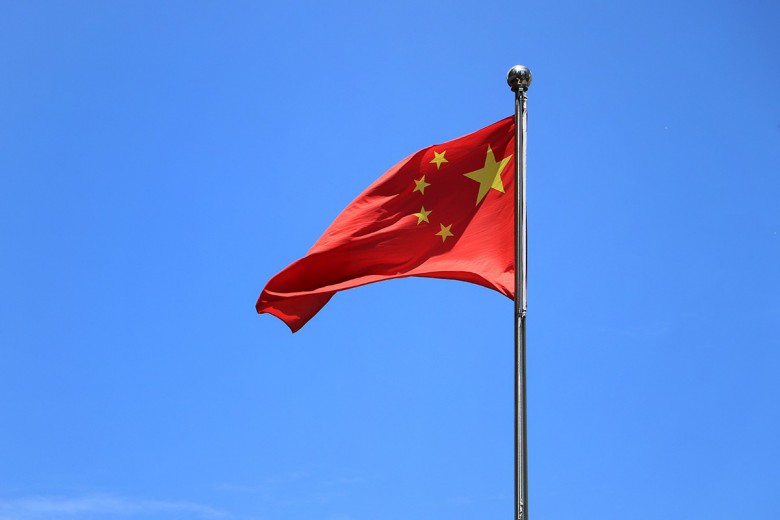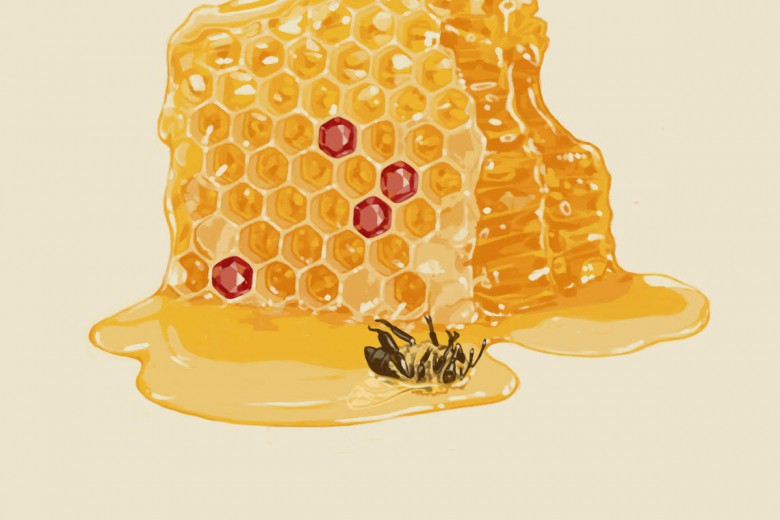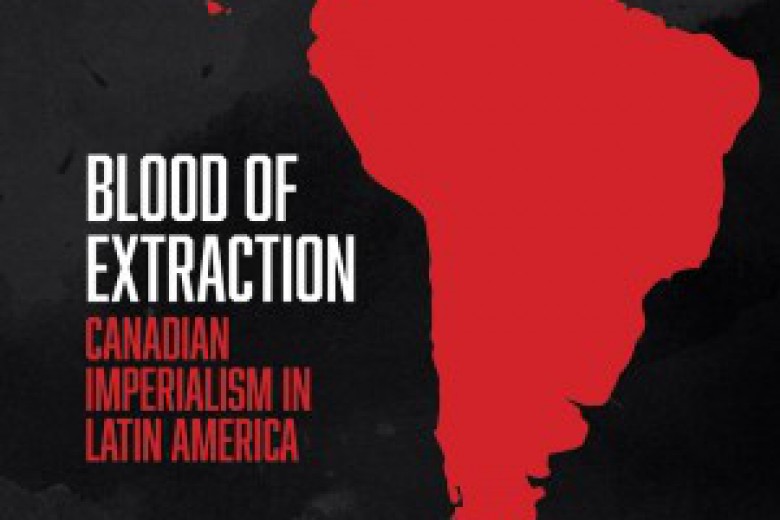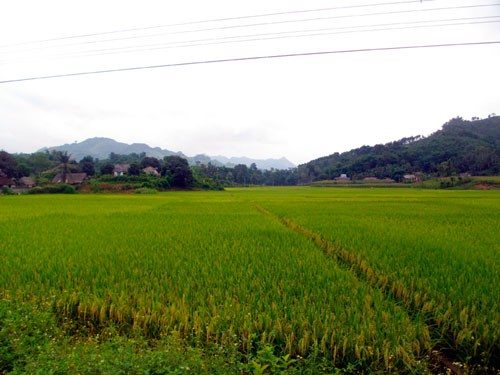
“Monsanto’s already here,” says Vuong Ngoc Quang, an organic farmer in the northern Vietnamese province of Tuyen Quang. We’re chatting over homemade apple wine and bitter melon tea amid hundreds of fruit trees at Quang’s co-operatively owned organic farm, Green Vietnam. With spare land used to intercrop vegetables and house pigs and chickens, and insects and companion planting used to control pests and weeds, Green Vietnam is a small haven of biodiversity in a countryside that is rapidly being overtaken by industrial-scale monocultures and biotechnology.
Biotechnology multinational Monsanto – better known today for its Roundup, Bt and terminator technologies – produced the herbicide Agent Orange, used to destroy the Vietnamese countryside and deny the guerrilla army their source of support during the Vietnam War. Today, half a century later, children continue to be born with genetic defects, and the soil in some areas remains dangerously toxic. Neither Monsanto nor the U.S. government has paid any reparations to Vietnamese people. Now the corporation is among a handful of powerful multinationals that, with the support of Western governments, including Canada’s, are priming Vietnam to become a hotbed of biotechnology development, with potentially devastating consequences for its land and people.
Agrarian industrialization
Vietnam is the second biggest rice exporter in the world. The country’s rice paddies, those emerald seas dotted with conical hats and water buffalo, have become emblematic of the nation’s countryside and are romanticized by the media and used by the booming tourist industry. But just over 20 years ago, the country was still importing rice, and agriculture was collectivized and controlled by the state.
Agrarian industrialization began in Vietnam with the introduction of Doi Moi – literally, renovation – in 1986. The country’s new economic plan signalled a shift toward a market-based economy while retaining the state’s communist political apparatus. Collectivized agriculture was abandoned in 1988 in favour of small-scale peasant holdings, the opening of land markets and the introduction of fertilizers and high-yield seeds. Integration in global markets has since deepened, especially after the United States lifted its trade embargo in 1994. Not long after, the Vietnamese government announced more systemic transformations, including a 1998 resolution that further liberalized land and labour markets in rural areas.
Agricultural production has increased so much since decollectivization that Vietnam is now a major exporter of rice, coffee and cashews and is poised to become a significant force in the global food market. Its status as an emerging economy was bolstered by its accession to the World Trade Organization (WTO) in 2007.
While the World Bank argues that agrarian reform has been fundamentally pro-poor, disproportionately benefiting the poorest members of society, others suggest that land holdings are concentrating in the hands of wealthier farmers. In the Mekong Delta, the country’s biggest rice basket, mechanical combines are rapidly replacing human labour. The proportion of landless, rural households in this region increased from 16.9 to 28.9 per cent between 1993 and 2002, forcing more rural farmers into agricultural wage labour or to urban centres in search of work.
Biotechnology as panacea?
Vietnam first declared biotechnology a national development priority in 1994, an announcement that conveniently coincided with the lifting of the American trade embargo and Vietnam’s initial membership application to the WTO. The country’s goals include developing its own genetic technologies for insect and disease resistance in food crops as well as technologies for livestock, post-harvest and processing, and reforestation. No fewer than a dozen institutes are devoted to biotechnology research on a range of crops.
In 2006, the country announced the commencement of field trials of a strain of genetically modified (GM) corn developed by agribusiness giant Syngenta, with the goal of commercializing production between 2011 and 2015. Regulatory progress has been slow although guidelines now exist both for importing and producing GM products in Vietnam. Any GM crop tested for large-scale production must undergo two risk assessment periods: one confined (for a two-season cycle) and one within a local ecosystem.
Nevertheless, GM crops were already grown in parts of the country before the guidelines were approved. A 2009 U.S. Department of Agriculture report noted that “much of the cotton being grown in Vietnam is GM.” To date, four agencies and one company have been permitted to do trial tests on cotton and corn with Bt, a bacterial pesticide that is spliced into the genes of food crops. Furthermore, Vietnam’s Ministry of Agriculture and Rural Development announced in March of this year that if all goes well with the trial Bt corn crops, commercial development of GM corn will begin in Vietnam in 2011.
Interrogating biotech: the limits of an export-oriented model of food security
Quang is wary of Bt If the pesticide reaches his farm and destroys even one organism that is necessary to Green Vietnam’s pest management system, it could disrupt the precarious balance they’ve created among the local insect populations. The malleability and unpredictability of genetic material, the traits at the root of biotechnology’s potential, are also its critical flaws. Nature adheres to no borders, Quang reminds me, especially those arbitrarily conceived by society and capital.
Furthermore, biotechnology only exacerbates soil exhaustion, which is already a problem in Vietnam. Since each plant requires a different assemblage of nutrients and minerals to produce the best food, repeatedly growing the same crops on the same land removes nutrients without returning them to the soil. When Quang started the farm about five years ago, it couldn’t sustain even the most meagre of plantings. “Before, the people [only] grew cassava and corn, [so] we had to feed the soil. It took us more than one year.” Biotech’s very goal is to continue increasing the productivity of a disconcertingly narrow number of crops on the same land.
The socio-economic effects of biotechnology are equally insidious and are being largely ignored by policy-makers in Vietnam. India’s tragic experience with GM cotton is illustrative. Not only has Monsanto recently admitted that its Bt cotton failed to solve the bollworm problem in parts of India, but its widespread cultivation has also left many peasants deeply indebted. After purchasing the high-priced seeds and artificial fertilizers on credit, many farmers lost their land when yields were not what they expected.
As a food security strategy, reliance on biotechnology also poses serious risks, especially as Vietnam begins dismantling its agricultural subsidies and protectionism due to deepening WTO commitments. Vietnam currently has some price subsidy policies in place (price floors for rice were raised several times in 2010), but these protectionist policies will end in the next year, according to WTO commitments, leaving Vietnamese farmers with no protection from price fluctuations. If the most recent report by the Food and Agriculture Organization of the UN is any indication, the volatility that has characterized global food prices since 2008 will continue into the foreseeable future, making an export-led food security strategy at best risky and at worst a gateway to increased dependence on global capital and widespread hunger.
The culpability of Canada and the Global North
Governments, NGOs and development agencies from the Global North play no small role in advancing the imperialist designs of the corporate food complex.
Canada is the sixth largest foreign investor in Vietnam and has a vested interest in the country’s further trade liberalization. The Canadian International Development Agency (CIDA) has been instrumental in pushing this agenda. The agency administers a CIDA Industrial Cooperation Program in Vietnam that “provides a financial incentive … to Canadian companies to start a business or provide training in developing countries or countries in transition to a market economy.” Whether any agricultural companies have, as of yet, taken advantage of this program is unclear. However, such market-based development programs are common. Both the Japanese and Danish development agencies (JICA and DANIDA, respectively) have similar programs that have funded large-scale projects in Vietnam aimed at improving agricultural export competitiveness and agricultural technologies.
One registered charity, the International Service for the Acquisition of Agri-biotech Applications (ISAAA), receives funding from private companies, like Monsanto, as well as the U.S. Agency for International Development, the U.S. Department of Agriculture, DANIDA and Canada’s International Development Research Centre (IDRC), among others. The founder and chair of the ISAAA, Clive James, has also served as senior agricultural adviser with CIDA.
The ISAAA administers a centre in southeast Asia for the transfer of various biotechnologies, and it’s eyeing Vietnam as one of the most promising new frontiers for commercialization. Currently they’re facilitating the research and development of an insect- and virus-resistant variety of sweet potato for production in Vietnam and the Philippines. The organization argues that “agriculture will continue to play a central role as Asia pursues the complementary goals of poverty reduction, sustainable food security, environmental conservation, and increasing trade competitiveness. New technologies, including crop biotechnology, will be essential to meet these challenges.”
IDRC also funds the Alliance for a Green Revolution in Africa (AGRA), a program whose goal is to bring small-scale African farmers further into the global agriculture system through providing seeds, fertilizers and market knowledge. Pitched as Africa’s answer to India’s mid-20th-century green revolution, AGRA is the current focus of groups in Canada trying to raise awareness and concern about biotechnology’s potential effects on food and livelihoods.
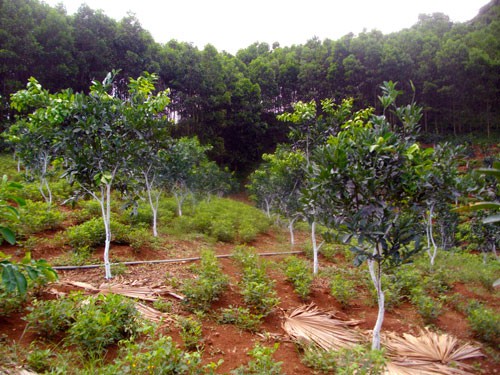
Green Vietnam: one alternative
Green Vietnam presents one alternative to a large-scale biotech agricultural model. “It’s a co-operative model,” says Quang.
Quang once lived on the streets of Hanoi and has since worked as a farm labourer and with victims of Agent Orange. “I understand what it is like to be a worker, so we treat our workers very well,” he says.
Two-thirds of the more than 50 workers employed by Green Vietnam own shares in the business. They are paid salaries on par with urban labourers, in addition to being provided with accommodation and good quality food. While they are primarily fruit farmers, they also keep livestock, grow vegetables and maintain an ecotourist lodge.
Despite being a stunning example of an alternative business model that supports the health of the land and those who work it, Green Vietnam is still heavily dependent on tourist dollars and high-interest bank loans. In short, it too is intimately linked to the emerging markets in land and labour. Nonetheless, Quang works tirelessly on outreach and awareness, trying to help other farmers move away from the industrial model by providing loans, co-operative labour and knowledge of organic practices.
Resistance to biotechnology
The lack of public outrage at the prospect of relinquishing local control over seeds and genetic diversity in a country where seed and chemical companies have already left an indelible mark on the land and its people is surprising. But genetic engineering is beginning to raise some eyebrows. In June 2011, a one-day workshop was organized in Hanoi by the Vietnam Peace and Development Foundation to bring together scientists, development professionals and concerned citizens for a frank discussion on the pace of biotech development in Vietnam. Since then, the foundation and local NGOs have begun to strategize about how to raise awareness and resistance to biotechnology in Vietnam, but the clock is ticking.
A number of international organizations are also working to resist the spread of biotechnology globally.
The Working Group on Canadian Science and Technology Policy is a collection of farming, human rights, development and church organizations that monitor Canadian policy in the Global South, particularly in terms of agricultural biotechnology and rural development.
Eric Chaurette of Inter Pares, one of the organizations involved in the working group, is adamant that “food security is not enough. How that food is produced, where it came from and under what conditions, and why those people have difficulty feeding themselves are not addressed.” He suggests we focus on food sovereignty. “Food sovereignty is about putting some political back into the policy and reclaiming power over our food systems.”
Same story, new setting
The industrial vision of GM agriculture advanced by the institutions and corporations of the Global North smacks of hubris reminiscent of the Dust Bowl in the 1930s, when farmers were compelled to exhaust the land and their labour in the name of commerce, resulting in severe soil damage, drought and massive dust storms across the Canadian and American prairies. Now agriculture has reached another precipice of global proportions that is no less about capital’s role in food production. And Vietnam, celebrated by the World Bank and Co. as the Global South’s latest development darling while it quietly reorganizes land and labour in profound ways, is a particularly important place to watch.
Take action!
Call on the International Development Research Council (IDRC) to halt their funding of the International Service for the Acquisition of Agri-biotech Applications. Contact David Malone, president of the IDRC, at (613) 236-6163 ext. 2599.
The Working Group on Canadian Science and Technology consists of representatives from a range of development, church and farmer organizations, including Inter Pares, National Farmers Union, Canadian Organic Growers, ETC Group, United Church of Canada, Social Justice Committee and USC Canada. For more information, please contact Inter Pares at [email protected] or by phone at 1-866-563-4801.


